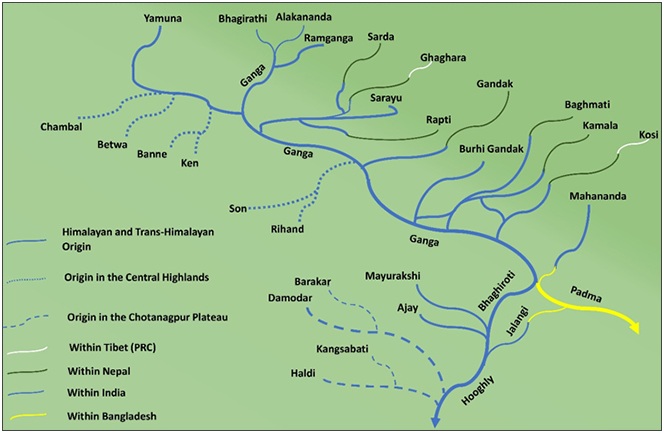Microplastics in Ganga more than any other major world river: Study
- Posted By
10Pointer
- Categories
Environment
- Published
23rd Jul, 2021
-
-
Context
As per a latest study conducted by Delhi-based non-profit Toxic Link, the Ganga is heavily polluted with microplastics at Varanasi, Haridwar and Kanpur.
-
What are microplastics?
- Microplastics are tiny plastic particles but a major source of pollution.
- They are non-degradable plastics.
- Size: They are less than five millimeters (0.2 inches) in diameter.
- Types:
- Ehylenevinyl: Used in food, drugs and cosmetic packaging.
- Polyacetylene: Used as a doping agent in the electronics industry.
- Polypropylene: Used in packaging, plastic sheets, fibre, fabrics, rope, etc.
- PIP: Used in footwear and baby bottle nipples.
- Polyamide (nylon): Used as a natural fibre and as metal wires in clothing and industry.
-
Key-highlights of the Study
- Title of the Study: Quantitative analysis of Microplastics along River Ganga
- Research area: Varanasi, Haridwar and Kanpur.
- Among the three cities, Varanasi (Assi Ghat) showed the maximum load of microplastics, as compared to the other two cities.
- This might be due to cumulative downstream pollution and also because of industrial and human activities.
- Kanpur’s Dohri ghat ranked topmost among all 15 sites (five each from all three cities) from where the river water sample was collected.
- Resins like EVOH, Polyacetylene, PIP, PVC and PVAL were predominantly present in all three locations.
|
Fourier transform infrared (FTIR) spectroscopy
- The samples were tested through the Fourier transform infrared (FTIR) spectroscopy.
- It is a technique used to identify small organic or inorganic material — to identify the exact type, or resin core present in the water.
|
-
Is Ganga microplastic pollution more than any other major world river?
- This research compared the microplastics concentration in Ganga water with similar studies on other rivers across the globe, like the-
- Rhine in Europe
- the Magothy, Rhode Patapsco in North America
- the Maipo, Biobio, Maule and Elqui in South America
- Compared to other cities, Ganga microplastics pollution was much higher.
- This finding is worrisome as there is higher per capita consumption of plastic in the European countries, North and South America, as compared to India.
-
What are the reasons behind high concentration?
- Industrial waste and religious offering: Microplastics often entered the Ganga through industrial waste or packaging of religious offerings.
- Population: The density of population in cities also adds to the problem because a large chunk of pollutants got directly discharged into the river by people living on the banks.
- Release of sewage waste: Sewage and / or industrial effluents are also responsible for the increased concentration.
-
Why the findings are of grave concern?
- The results of this study are a matter of grave concern not just for academic and scientific interests but also from the public health perspective.
- The Ganga is a source of water for not just drinking and bathing purposes but also for irrigation to a large extent.
- The river is acting as a carrier of plastics and microplastics and transporting significantly large quantities into the ocean.
|
Ganga River Basin
- Ganga is a sacred body of water to Hindus.
- It begins high in the Himalaya Mountains (Gomukh, the terminus of the Gongotri Glacier) and empties out into the Bay of Bengal.
- When the ice of this glacier melts, it forms the clear waters of the Bhagirathi River.
- As the Bhagirathi River flows down the Himalayas, it joins the Alaknanda River, officially forming the Ganges River.
- The Ganges River Basin is sometimes considered part of a larger river basin consisting of the nearby Brahmaputra and Meghna rivers.
- Known as the Ganges-Brahmaputra-Meghna (GBM) River Basin, it is one of the largest river systems in the world.

|
-
How does it impact people?
- Toxicity: Microplastics in river water, if ingested in humans or other organisms, can cause toxicity through various means. Not only are these microplastics toxic themselves, they also have a tendency to absorb various toxins present in water, including harmful chemicals.
- Food chain: Microplastics can enter human bodies consumption of sea food and also through use of products that contain nanoplastics such as scrubs, lipsticks, mascara, shampoos etc.
- Oral, dermal and inhalation exposure: Other than the food chain, constant contact with day-to-day life plastic products allows oral, dermal and inhalation exposure to microplastics and additive chemicals to human body.
- Affected marine life: Microplastics damage aquatic creatures, as well as turtles and birds.
-
Conclusion
Microplastics are evidently everywhere and it is not just affecting people’s lives but the entire ecosystem. India, despite being a major hotspot does not have proper knowledge and research on the topic. Thus, research is urgently needed in order to have an effective solution for this global issue.